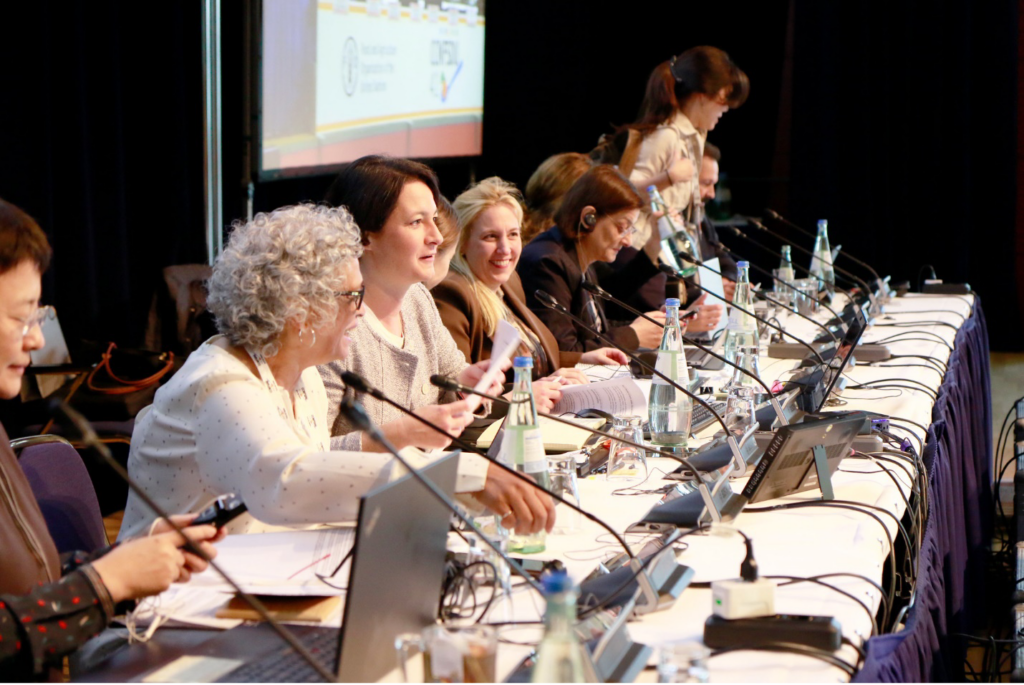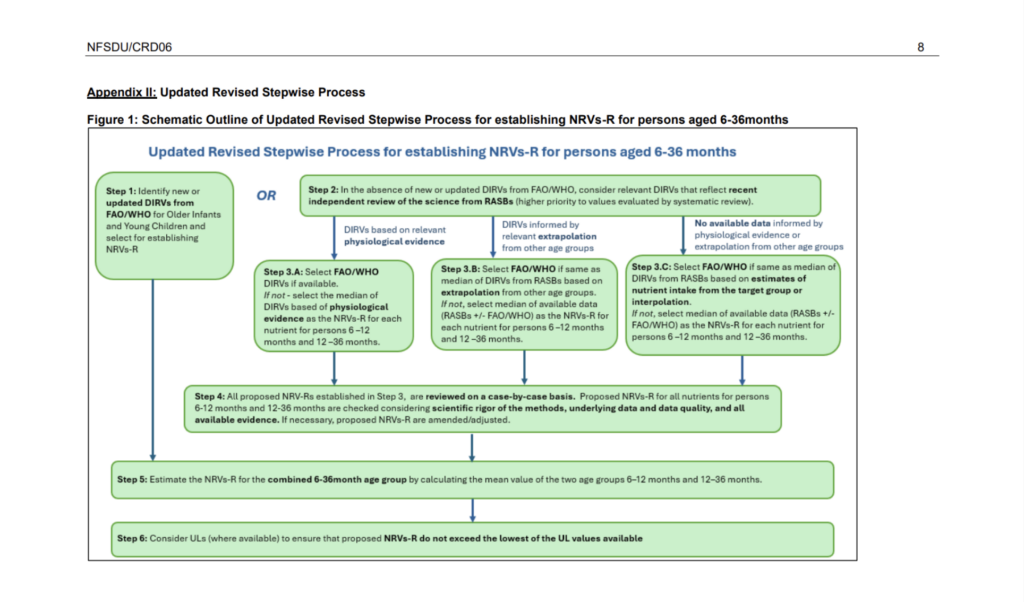
Setting the Nutrient Reference Values for Infants & Children
By Scott C. Tips

On the banks of the Elbe, in the city of Dresden, Germany, the Codex Committee on Nutrition and Foods for Special Dietary Uses (CCNFSDU) met for its 44th session from September 30 through October 6, 2024. The National Health Federation (NHF) was there as a Codex-accredited organization for its 28th-straight meeting in that committee – still the only one representing health freedom. About 200 or more other delegates and observers joined the NHF at this meeting.
Although there were a number of issues on the CCNFSDU agenda, the primary interest for the NHF was the establishment of healthy Nutrient Reference Values (NRVs) for older infants and young children. As you will see, though, the referent values used by the committee to establish these NRVs all came from a handful of mainstream scientific bodies recognized by Codex as “authoritative.” In Codex-speak, they are called Recognized Authoritative Scientific Bodies (RASBs), Except for values set by the FAO/WHO, no other scientific values may be considered, no matter how accurate they might be. I find this approach highly restrictive, dangerously biased, open to influence from the highest bidder, and likely to lead to errors – kind of like limiting yourself to just watching a few network television news programs and expecting that approach to give you complete and truthful intel.
The Working Group for Children’s NRVs
To get to this meeting, I flew in to Prague airport and took the intercity train to Dresden as that was less expensive than arranging a flight directly to the small airport servicing Dresden. That was on the plus side. On the minus side, I had to awaken at 2:15 a.m. that morning to make the flight to Prague.
Arriving on Monday afternoon, September 30th, I was in time for the ad hoc Physical Working Group (PWG) meeting that started the next morning. Ably chaired by the delightful Irish delegate Dr. Mary Flynn, this PWG was to discuss both the general principles for setting the NRVs and the actual values for Vitamins A, D, C, K, and E, thiamine, riboflavin, niacin, Vitamins B6 and B12, folate, pantothenic acid, biotin, calcium, magnesium, iron, zinc, iodine, copper, selenium, manganese, phosphorus, and potassium for these older infants and young children.
Remember, PWGs are essentially sub-committees of the Codex Committee and are intended to save working time at the plenary sessions. While PWG reports and recommendations to the full Committee do not have to be followed, they carry a lot of weight and generally are followed. So, it is wise to attend the PWGs and weigh in with your positions there, as well as at the plenary meeting that follows.
The Hand Reaching Out From Retirement
Surprisingly, I found out that Dr. Janine Lewis – the now-retired head of the Australian delegation for CCNFSDU meetings, and the chief architect of the disastrously inadequate NRVs for adults that NHF fought to a standstill (and even later improved upon) for several years in 2009-2013 – had had a hand in the development of these NRVs for older infants and young children. The PWG chairwoman Mary Flynn praised Dr. Lewis for her help, while I could only cringe with the knowledge that, once again, we were facing dismally low levels of nutrients being set, this time for children. At least now I knew from whence the inspiration for these shockingly low levels had originated.
The NRVs for Persons Aged 6-36 Months
The PWG considered the values proposed in the following chart:

This Codex committee – like so many others – has a quaint view of how science works. When widely disparate views exist in establishing a particular intake value for a nutrient, instead of selecting the most scientific standard (that is, numerical value), the committees will often “compromise” on what the value should be. That is, they will select the average of the values. It’s as if the Vatican Tribunal, when trying Galileo for the heresy of professing the belief that the Earth revolved around the Sun, decided that a compromise was the best way to avoid scientific conflict and announced that the Sun and the Earth revolve around each other!
Plus, they treat incredibly safe vitamins and minerals as if they are as dangerous as loaded guns. It wouldn’t surprise me one bit if many of these delegates willingly submitted to the experimental and dangerous COVID-19 injections while refusing to take any vitamin supplements as a wasted effort or even a threat to their health.
Now, not all of the delegations wanted an average of the RASB values to be selected by Codex as the NRV for children’s vitamins and minerals. Some delegations (the EU, New Zealand, and Norway) argued that – for “safety’s sake” – the lowest value of these dangerous vitamins and minerals should be selected, while other delegations (the United States, China, Panama, Chile, South Africa, NHF, and ISDI[i]) argued that the highest value should be selected.
The NHF argued in favor of the highest values, stating that, “You need the higher values to catch the ‘outliers’ who need more than the average nutrient values. And since we are dealing with one of the safest consumables on the market, the risk to any other children is minimal to non-existent. Besides, there are certain things you simply cannot compromise on – between clean and dirty, you are still dirty; freedom and slavery, you are still a slave; and illness and wellness, you are still ill. For those reasons and more, NHF supports the highest nutrient values.”
Yet, in the end, compromise won out over good nutrition. Codex has increasingly shied away from any uncomfortable confrontations that might offend in favor instead of compromises that will satisfy everyone but science itself. I have noticed that the female Codex leaders and heads of delegations are major drivers of this approach and deft masters of the art of compromise, but the men are in there too and more than happy to play the compromise game.
The Stepwise Process To help visualize the process of arriving at these NRVs, both the PWG and the Committee have created a typically bureaucratic flow-chart for “The Stepwise Process,” which focuses on recent FAO/WHO nutritional data and ignores most other available data unless, in some instances, it comes from an RASB. See the following chart.

Vitamin D NRVs
Although the NRV for Vitamin D for older infants and young children had originally been set at 5 micrograms (200 IUs) per day, during its discussion in the PWG, upon presentation to the full committee, the proposed NRV was doubled to 10 micrograms (400 IUs) per day. Evidently, the NHF’s and others’ arguments that the nutrient levels should be increased had had some effect.
The NRV level for Vitamin D is still low but improved with the doubling. Once again, limiting NRVs to only those espoused by FAO/WHO and the handful of mainstream RASBs drastically narrows the possibilities of arriving at an optimal nutritional status for children.[1]
Magnesium NRVs
The PWG and the committee wanted to set the magnesium NRVs for older infants and younger children at a laughable 80 milligrams per day. And this was even without taking into consideration the calcium NRV, which was being set at 400 milligrams per day!
As I told both the PWG and the full committee once again as in previous meetings, “calcium and magnesium are twin minerals that operate within the body together. You cannot set the value of one without considering the value of the other. That’s because neither can act at the biochemical level without eliciting a response from the other. Growth of cells, cell division, and intermediary metabolism – all important to infant health and growth – are absolutely dependent upon the availability of magnesium, which can be compromised if excess calcium is present.[2] Our paleolithic ancestral diet had a ratio of calcium-to-magnesium intake of 1:1, but our modern diet has a dietary-intake ratio that ranges between 5:1 and 15:1. In fact, cellular magnesium deficit causes inflammation independent of injury or pathogens.”[3]
Because the NRV that I was advocating had not been suggested by any RASB, I had to argue in favor of the best RASB-suggested NRV. That was the 170 mg/day level established by the Nordic Council, the use of which would reduce the calcium-to-magnesium ratio to 2.29:1 (the calcium NRV having been reduced to 390 mg/day).
Fortunately, an unlikely ally on the NRV issue, the European Union delegate and her EFSA colleague, the latter of whom spoke up to oppose the magnesium NRV being set at this low of a level, with the EU delegate correctly citing recent developments and studies on diabetes.[4] Curiously, the EU delegate also added that the committee should apply Step 4 of the Stepwise Process to analyze the quality of data. This seemed to contradict her other statements that FAO/WHO data should not be scrutinized by the committee.
Regardless, for both this NRV and the NRV for Vitamin B12, the committee wisely chose to hold back any decision pending the next meeting of the CCNFSDU, which will take place in 2026 and probably in Panama City, Panama.
The EU – Sock Puppet for the FAO/WHO
The European Union head of delegate went out of her way on two occasions to emphatically insist that the Codex Nutrition committee should never question the FAO/WHO data given to the committee to set its NRVs. What motivated her to state this with such surprising religious fervor I shall probably never know. But it certainly motivated me to take the floor and challenge that statement with NHF’s observation that, “We at Codex are risk managers and not risk assessors, and as such we have not only the right but the duty to scrutinize FAO/WHO data whenever we so choose. In my 25 years of attending these meetings, I have never seen this happen, but the right exists nonetheless, and we should not forget it.” The EU delegate would reduce the CCNFSDU to simply being a rubberstamp for the FAO/WHO.
Final Observations
The Codex Nutrition Committee meeting was run very smoothly by its chairwoman and co-chairwoman. The Chairwoman of the PWG is also to be commended, especially for specifically bringing up an issue for the working group after I made a side comment to her, which I had thought was ignored. Well, it wasn’t, and PWG Chairwoman Mary Flynn was considerate enough to make sure to raise NHF’s point to the entire group. Sadly, the United States silently sat on its hands instead of grasping this opportunity, even though NHF’s proposal directly supported the stated U.S. position on selecting the higher values. Sometimes, some people can just not be helped.
All in all, while the committee’s consensus decisions on setting NRVs resulted in less-than-optimal levels of vitamin and mineral NRVs being established for vulnerable older infants and young children, but at least no one’s feelings were hurt during the process.
© 2024 Scott C. Tips
[1] The International Special Dietary Foods Industries, an INGO accredited by Codex. See www.isdi.org.
[2] See A. Corsello & G. Spolidoro, “Vitamin D in pediatric age: Current evidence, recommendations, and misunderstandings,” Frontiers in Medicine, 2023, 10: 1107855, at www.ncbi.nlm.nih.gov/pmc/articles/PMC10060648/#:~:text=Infants%20400%20IU/day%20in%20the%20first%20year%20of%20life%20in.
[3] See, e.g., Walker GM, “Biotechnological implications of the interactions between magnesium and calcium,” Magnes Res., Vol. 12, No. 4, pp. 303-309 (1999).
[4] Ibid.
[5] It is important to note that between 1994 and 2001, the prevalence and incidence of type 2 diabetes in the United States increased sharply as the ratio of calcium-to-magnesium intake from food rose from below 3.0 to above 3.0. See, e.g., Andrea Rosanoff, Connie M Weaver, Robert K Rude, “Suboptimal magnesium status in the United States: are the health consequences underestimated?” Nutr Rev., 2012 Mar ;70(3):153-64. Epub 2012 Feb 15. PMID: 22364157; at https://greenmedinfo.com/article/health-consequences-suboptimal-magnesium-status-united-states-are-underestimat.

[…] väljas, medan andra delegationer (Förenta staterna, Kina, Panama, Chile, Sydafrika, NHF och ISDI[i]) hävdade att det högsta värdet skulle […]